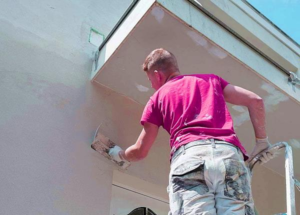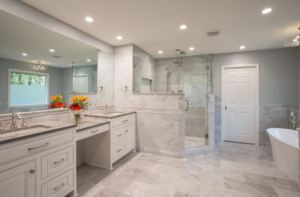The first step to stucco repair is a thorough assessment of the damage. Stucco contractors will look for cracks and fissures as well as check that gutter downspouts are properly pointing water away from the wall structure.
Remediation is a more in-depth service that deals with the underlying issues causing moisture penetration into the space between the brown coat and the lath. It’s a much more expensive option than simple repair, but it will prevent future damage. Contact Stucco Repair Philadelphia PA now!

When it comes to stucco damage, it’s often more than a simple repair job. Remediation is a more involved process that addresses severe underlying issues that can cause further problems for your home. It involves removing all layers of stucco down to the base layer, fixing any underlying issues, and then applying new stucco layers.
Remediation is more expensive than a simple stucco repair, but it’s the best way to fix your home’s structural integrity and protect the interior from moisture damage as well. Moisture caused by a serious underlying issue can be incredibly destructive to a home’s structure and lead to mildew, mold, and wall rot. If the moisture damage isn’t fixed, it can spread to the framing and support structures of your home causing significant structural damage and costing you thousands of dollars in repairs.
Before you start your stucco remediation, you should walk around the exterior of your home and look for cracks, chips, holes, buckling, and bubbles. If you find any of these signs, it’s important to contact a professional immediately for a free estimate.
If the damage is superficial, a repair might be all that’s needed. Hairline cracks can usually be filled with joint compound, but if the cracks are wide or extend down the foam trim it may indicate that there is a bigger problem and a full stucco remediation will be required.
To start the remediation process, remove any debris from the damaged area and vacuum the area thoroughly to prevent dust from getting back into the cracks. Then, use a wire brush to clean the surface of the wall. This will remove any loose particles, dirt, or mold/mildew and promote a better surface for adhesion during the application of the new stucco.
Next, inspect the condition of the metal mesh lathing that supports the stucco. If it’s rusty or severely damaged, it needs to be replaced. To do this, first, remove any remaining pieces of old mesh with metal snips or wire cutters. Then, measure the area that requires new mesh and cut a piece to size. Finally, attach the new mesh using galvanized nails driven into the wood lath underneath.
Repair
Stucco is a great material for exterior walls. However, it can get damaged and may need to be repaired. There are several ways to repair stucco, including cladding, caulking and sealants, and patching holes. If the damage is extensive and has been there for a while, then replacement of the affected areas may be necessary.
Before beginning a stucco repair, it is important to assess the damage. Take note of any cracks, holes, discoloration and other signs of moisture intrusion. It is also important to check for mold and mildew. If there is any, then a thorough scrub with a mix of one part bleach and four parts water should be done immediately to prevent further damage.
After assessing the damage, it is necessary to protect any exposed lath with builder’s paper. This will help ensure that no moisture gets trapped in the wall, and also that any future cracks are protected. Once the area is covered, the underlying lath should be cleaned with a wire brush to remove any loose particles, and it should be washed to ensure that there is no mold or mildew present.
Then, using a trowel with the notched side scored over the entire surface of the damaged area, apply a thin layer of the stucco patch mix. Use a trowel to work the mix into the cracks, making sure that it is smooth and blending in with the existing texture. Cover the area with a piece of plastic and secure it with painter’s tape. This will allow the stucco patch to dry without being exposed to bad weather, and it will give it a better bond with the surrounding stucco.
Once the patch has dried, a final application of the stucco mix can be applied. Again, it is important to be patient and to apply the mix in layers if the damage is severe. During this stage, it is recommended to use the trowel again with the notched surface to create a smooth texture that will blend in with the rest of the stucco.
Depending on the severity of the damage, it may be necessary to add color pigment to the stucco mix to match the existing wall. This can be done by mixing small batches and adding pigment to see what is needed. It is also a good idea to periodically mist the area to avoid drying too quickly.
Replacement
The best way to determine whether a stucco repair is needed is to assess the extent of damage. The size of the home plays a role as well because the more stucco that needs to be repaired, the longer it will take for contractors to complete the project. In some cases, it may be necessary to remove portions of the damaged stucco. Once the old stucco is removed, the area must be thoroughly inspected and cleaned to ensure that the foundation for the new stucco is in good condition. This includes removing any underlying debris such as rot, mold, mildew and insects. It also means ensuring that the metal mesh is intact. If the mesh is severely damaged, it must be replaced to allow for proper stucco adhesion.
After a thorough inspection, a contractor will determine the best course of action for repairs and replacement. If the problem is caused by a faulty drainage system or water seepage, it will be necessary to fix these issues before resurfacing. This will prevent the same issues from reoccurring and save the homeowner time, money, and energy in the future.
Once the underlying problems are resolved, the damaged areas of the stucco will be repaired and coated with fresh plaster. This will restore the structural integrity of the building and improve its appearance as well. The coating will be applied using a roller or brush to get into all of the nooks and crannies of the stucco texture. A high-quality, thick coat is recommended, as this will protect the underlying repair and help it last longer.
It’s important to remember that cracked, chipped or discolored stucco can cause serious structural problems if not repaired quickly. Cracks and soft spots are easy to penetrate and accept moisture easily, leading to mold growth and internal damage that weakens the walls of a house. To minimize the risk of this, it’s a good idea to do a walk around your home and inspect the stucco exterior on a regular basis.
It’s not just about curb appeal; a damaged stucco façade can decrease the value of a property and leave homeowners with costly maintenance and repair bills in the future. It’s essential to take care of any stucco issues as soon as possible, especially in California, to avoid moisture penetration that leads to health problems and costly property damage.
Maintenance
Stucco is a beautiful and durable exterior finish for homes, providing a unique opportunity for customization and design expression. However, like any other material, it requires regular maintenance to ensure its longevity. The key is to catch damage early and have it repaired promptly before the problem worsens.
The most common type of stucco damage is cracking and crumbling, which can be caused by a number of factors, including the environment and the quality of the original installation. It can also be the result of water penetration. Moisture intruding through damaged stucco not only ruins the surface of your walls, but can also lead to mold and rot within the wall structure.
Stucco damage repair starts with a thorough inspection of your home’s stucco system to determine if the issue is related to an underlying problem. This process should include a close examination of the areas around your windows and any other connection points with your roof and house.
If no underlying issues are found, it is often possible to perform a simple repair to the affected area. Depending on the extent of the damage, it may be necessary to clean the crack and apply a bonding agent to ensure proper adhesion. Next, you will need to fill the crack with a stucco mix, using a trowel to create an even surface and match the existing texture of your home’s stucco. Finally, it is important to ensure the new repair is kept moist until it has cured sufficiently to be painted.
When it comes to staining stucco, the first step is to clean the surface to remove dirt and debris. Then, it is important to choose the right paint for your stucco. Typically, a roller with a thick nap is ideal as it can easily navigate the texture of your stucco, pushing the paint into every crevice. Finally, it is important to allow the paint to dry and reapply as recommended on the label.
As with stucco repair, staining is best left to professionals who have the experience and tools to achieve consistent and attractive results. In addition to the expertise, a professional can help you decide whether to use a water-based or solvent-based paint, which will have a significant impact on how long your stain lasts.

